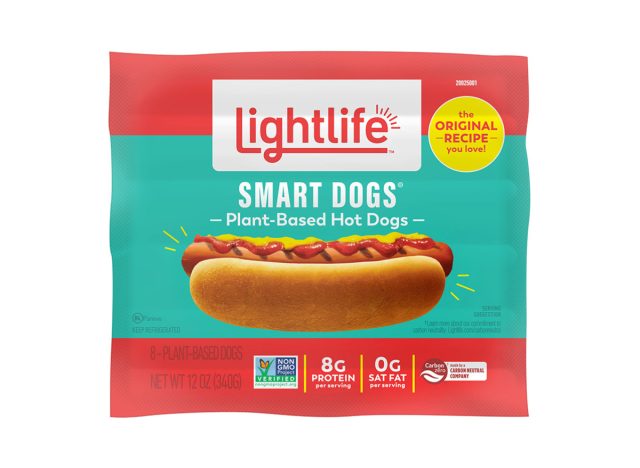Whether enjoying them at a ball game or a backyard BBQ, hot dogs are an American cultural icon and a staple food for many. According to the National Hot Dog and Sausage Council, Americans spent over $7.5 billion on hot dogs and sausages last year.
The classic hot dog, however, is no longer made from just beef. There are options for everyone, including chicken dogs, turkey dogs, veggie dogs, and fake meat products made from soy protein, pea protein, and wheat gluten. But other ingredients in hot dogs could be causing serious harm to your health.
Hot dogs may be delicious, but they’re not necessarily good for you. That’s because hot dogs are an ultra-processed, cured meat high in saturated fat, calories, added sugars, and sodium nitrite—a common preservative used in processed meats linked to cancer, heart disease, and diabetes. The World Health Organization (WHO) classified processed meats as carcinogenic to humans. That’s because eating 50 grams of processed meat (about one hot dog) per day spikes colorectal cancer risk by 18 percent.
If you can’t imagine a July 4th cookout without hot dogs, don’t worry. There’s no need to swear them off for good since not all franks are created equal. But it’s probably in your health’s best interest to stay clear of these four hot dog brands. If you’re looking for what hot dogs you should buy, we have that for you, too.
PER 1 FRANK: 230 calories, 20 g fat (9 g saturated fat), 45 mg cholesterol, 710 mg sodium, 2 g carbs (0 g fiber, 2 g sugar), 9 g protein
If you want to protect your heart health, leaving these hot dogs at the grocery store is best. They’re exceptionally high in calories, saturated fat, and sodium—three contributors to obesity, heart disease, and high blood pressure. A single frank contains 230 calories, nine grams of saturated fat (45 percent of your daily value), and a whopping 710 milligrams of sodium.
The Dietary Guidelines for Americans (DGA) advises everyone to keep saturated fats below 10 percent of their daily calories. Since fats are more calorically-dense than other nutrients by providing nine calories per gram, eating one of these hot dogs will provide 81 calories from saturated fats alone. Considering that many eat two, three, or more hot dogs at a time, it’s easy to see how consuming them will put you over your maximum daily saturated fat intake. According to the American Heart Association (AHA), eating high amounts of saturated fat will increase “bad” LDL cholesterol levels while raising your risk of heart disease and stroke.
Brittany Lubeck, RD, a registered dietitian and nutrition writer, tells Eat This, Not That!, “Ball Park’s uncured beef hot dogs are high in fat, with one frank setting you back 20 grams of total fat. The dietary reference intake (DRI) for fat is 20 to 35 percent of total calorie intake. So for many people (like those eating 2,000 calories daily), one of these hot dogs could make up almost half their allotted total fat intake for one day!”
The DGA recommends not exceeding 2,300 milligrams of sodium per day for healthy adults. Many people with high blood pressure shouldn’t exceed 1,500 milligrams. You’ll see that eating just three of these hot dogs will put you close to your maximum daily sodium intake of 2,130 milligrams. And that’s not including all the condiments, toppings, and other high-fat, salty foods you eat in a day.

PER 1 FRANK: 45 calories, 0 g fat (0 g saturated fat), 15 mg cholesterol, 430 mg sodium, 5 g carbs (0 g fiber, 2 g sugar), 6 g protein
Even though these hot dogs boast 45 calories per frank and zero saturated fat, they should still be kept off your grill. Turkey may be a leaner option than beef, but these are still loaded with sodium at 430 milligrams per frank. Also, these franks contain mechanically separated turkey meat.
“According to the U.S. Department of Agriculture (USDA), mechanically separated meat is a paste-like and batter-like meat product produced by forcing bones, with attached edible meat, through a sieve under high pressure,” says Lubeck. “You’re left with a combination of bones, tendons, ligaments, and a bit of turkey meat in your hot dog. You may even be eating some blood vessels, skin, and nerves.”
In short, the meat used in these hot dogs isn’t coming from the best parts of the turkey. According to the European Food Safety Authority (EFSA), mechanically separated meat poses health risks because the high-pressure production process increases the risk of bacterial growth in the meat. Mechanically separated meat is also less nutritious and more susceptible to contamination.

PER 1 FRANK: 90 calories, 7 g fat (2 g saturated fat), 25 mg cholesterol, 410 mg sodium, 4 g carbs (0 g fiber, 1 g sugar), 5 g protein
Gwaltney’s chicken dogs are lower in saturated fat and sodium than beef dogs, with 1.5 grams of saturated fat and 470 milligrams of sodium per frank. However, these chicken dogs are made from mechanically separated chicken. “Mechanically separated meat means you’re not getting all the advantages of choosing chicken over beef. Instead, you’re more than likely eating bones, tendons, skin, and blood vessels in addition to a smaller than expected amount of actual chicken,” states Lubeck.
These franks also contain natural flavors, which are added to enhance taste and boost sales. Unfortunately, many natural flavors, such as monosodium glutamate (MSG), are linked to obesity, organ damage, and metabolic disorders. Natural flavors can also cause issues for people with allergies, reports FoodRevolution.org.
“The ingredient list on these chicken hot dogs mysteriously contains ‘flavorings,’ which could mean almost anything. It’s a good idea to know exactly what you’re putting into your body whenever possible,” advises Lubeck.

PER 1 LINK: 60 calories, 2 fat (0 g saturated fat), 0 mg cholesterol, 350 mg sodium, 2 g carbs (0 g fiber, 1 g sugar), 8 g protein
To enhance the flavor of their meatless dogs, Lightlife Smart Dogs are highly processed and contain less than ideal ingredients, such as soy protein isolate (SPI), canola oil, artificial sweeteners, guar gum, and xanthan gum. Artificial sweeteners in particular are known to drive up inflammation in the body, says a 2021 study published in Frontiers in Nutrition.
While soybeans are a healthy plant-based protein source, SPI is chemically engineered to isolate the protein—a process that strips the soybean of its many nutrients. “Unlike natural soy, soy protein isolate is a highly processed option made by removing the fiber, vitamins, minerals, and other natural ingredients from soy and leaving just the protein,” explains Lubeck. “The problem with soy protein isolate is that the process of making it means the product often contains chemicals and metals, two things you don’t want to eat in large amounts regularly.”









